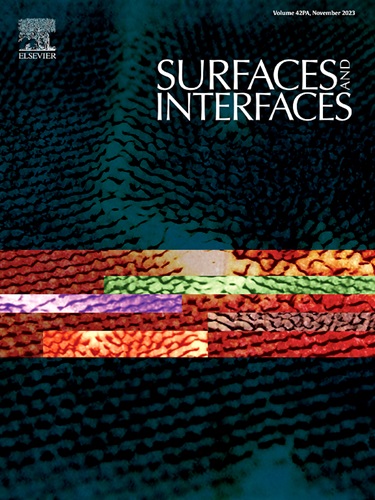Regulation of SnO2 ETL by Diphenylsulfone for highly efficient MAPbI3 based PSCs over 21.2% in open Air
IF 5.7
2区 材料科学
Q2 CHEMISTRY, PHYSICAL
引用次数: 0
Abstract
Non-radiative recombination due to high-density defects at the bottom of the perovskite layer and in the SnO2 ETL layer is not favourable for charge transfer. In this work, disodium diphenylsulfone-4,4′-dichloro-3,3′-disulfonate (SDCDPS) was introduced into SnO2 solution to prepare a high-quality pinhole-free SnO2 film. The sulfonate of SDCDPS collaborates with diphenylsulfone to passivate uncoordinated Sn4+ in SnO2 ETL, which will reduce the work function (WF) in the SnO2, increasing the conduction of SnO2 film and reducing the charge recombination of pre-buried interface. Besides, the sulfonate and diphenysulfone groups also passivate the uncoordinated Pb2+ in perovskite to increase the crystallinity of perovskite and reduce non-radiative recombination. After SDCDPS modification, the power conversion efficiency of perovskite solar cells significantly increased from 18.2% to 21.2% with hysteresis factor decreasing from 10.4% to 3.35%. Also, the modified device shows well stability due to the enhancement of perovskite crystallization and the reducing defects. Under relative humidity of ∼60%, the PCE of the unencapsulated device modified by SDCDPS remains at 81% of the initial device after 720h. This work offers a dependable method for enhancing the quality of the buried interface in PSC and to pursue productive and consistent devices.
二苯砜对二氧化锡 ETL 的调节,使基于 MAPbI3 的高效 PSC 在开放空气中的发光率超过 21.2
过氧化物层底部和二氧化锡 ETL 层的高密度缺陷导致的非辐射性重组不利于电荷转移。在这项工作中,将二苯基砜-4,4′-二氯-3,3′-二磺酸钠(SDCDPS)引入二氧化锡溶液,制备出了高质量的无针孔二氧化锡薄膜。SDCDPS 的磺酸盐与二苯砜协同钝化 SnO2 ETL 中未配位的 Sn4+,从而降低 SnO2 的功函数(WF),增加 SnO2 薄膜的传导性,减少预埋界面的电荷重组。此外,磺酸盐基团和二苯砜基团还能钝化包晶石中未配位的 Pb2+,从而提高包晶石的结晶度,减少非辐射重组。经过 SDCDPS 修饰后,透辉石太阳能电池的功率转换效率从 18.2% 显著提高到 21.2%,滞后因子从 10.4% 降低到 3.35%。同时,由于包晶石结晶度的提高和缺陷的减少,改性后的器件具有良好的稳定性。在相对湿度为 60% 的条件下,经过 SDCDPS 修饰的未封装器件的 PCE 在 720 小时后仍保持在初始器件的 81%。这项工作提供了一种可靠的方法来提高 PSC 中埋入界面的质量,并实现器件的高产和一致性。
本文章由计算机程序翻译,如有差异,请以英文原文为准。
求助全文
约1分钟内获得全文
求助全文
来源期刊

Surfaces and Interfaces
Chemistry-General Chemistry
CiteScore
8.50
自引率
6.50%
发文量
753
审稿时长
35 days
期刊介绍:
The aim of the journal is to provide a respectful outlet for ''sound science'' papers in all research areas on surfaces and interfaces. We define sound science papers as papers that describe new and well-executed research, but that do not necessarily provide brand new insights or are merely a description of research results.
Surfaces and Interfaces publishes research papers in all fields of surface science which may not always find the right home on first submission to our Elsevier sister journals (Applied Surface, Surface and Coatings Technology, Thin Solid Films)
 求助内容:
求助内容: 应助结果提醒方式:
应助结果提醒方式:


